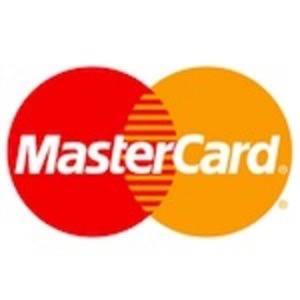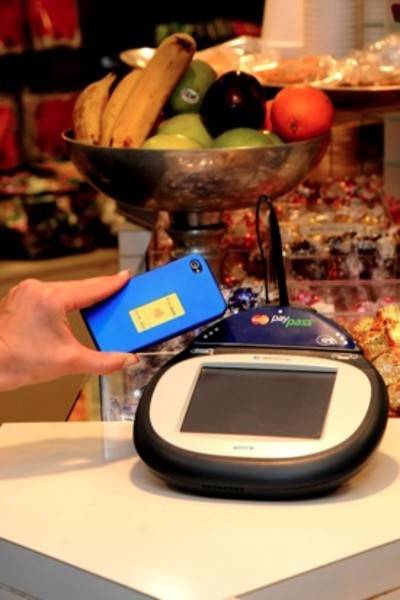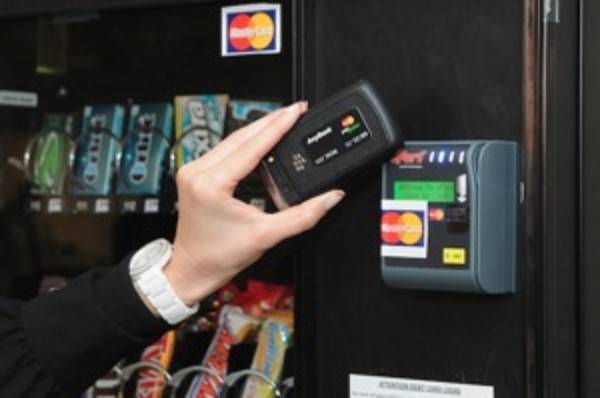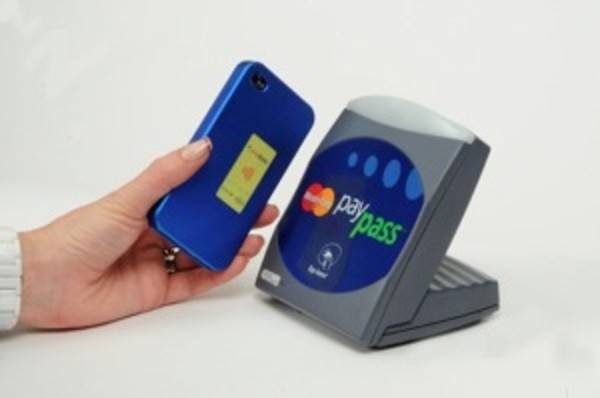MasterCard has been looking into mobile payments since 2001, says James Anderson, VP, Mobile at MasterCard. It has explored the industry by offering things like PayPass-enabled credit cards, PayPass key fobs and even PayPass stickers, all of which allow consumers to pay for items with tapping, instead of swiping a card. Today, the company is delving into the use of an emerging technology called NFC, or near field communication.

In 2011, Anderson says we’ll see a number of rollouts of NFC initiatives from MasterCard, including SIM-based solutions, embedded solutions and the continued deployments of NFC tags. By 2012, these efforts will have ramped up significantly.
The company has known for some time that mobility – that is, mobile payments – would be a game changer for consumers, explains Anderson. And it believes that NFC is the technology which will allow that shift to occur.
This post is part of a series on NFC here on ReadWriteMobile which will serve to get you up to speed on what NFC is, what notable developments are underway and what commercial programs using NFC will arrive this year. You can follow this series by clicking the tag (or bookmarking the tag) “NFC 2011.”
This post assumes you are familiar with the term NFC as well as the technology’s use in mobile payments. If you’re just starting to learn about NFC, you should begin here with the first post in the series to get caught up.
A History of Mobile Payments: Looking Back at PayPass

To get consumers comfortable with the idea that you can tap an object, like a credit card, key fob or mobile phone, at the point-of-sale, MasterCard introduced PayPass back in December of 2002. This “contactless” payment program was initially trialed in select markets with banking customers like Chase, Citibank, MBNA and others, and then began to slowly roll out via commercial deployments over the years. In 2004, McDonald’s began accepting PayPass, for example. MasterCard also worked with Motorola to test NFC technology that year. (Yes, NFC has been around for some time!)
In 2005, several football stadiums, convenience stores, and gas stations signed on to the PayPass program. By 2007, there were 28 million PayPass devices accepted by 80,000 merchants – a list that now included KFC, more McDonald’s locations, BP and Taco Bell. Another NFC trial with Canada’s Bell Mobility began in 2008. And by 2009, more big-name merchants had joined the program, including Hess, Sports Authority, Best Buy and others. Also by this point, PayPass has also been in overseas markets for years.
During 2009 and 2010, MasterCard began a number of new NFC initiatives, including rollouts of various NFC programs in Turkey, Signapore and the U.K. and began working with Bell Mobility in Canada to introduce NFC-enabled phones.
Today, there are approximately 88 million PayPass cards and devices in use at 276,000 merchant locations, plus trials and rollouts underway in 36 countries.
Why is the history of PayPass important? And what does it have to do with NFC? Well, where there’s support for “contactless” payments like PayPass, there can be support for NFC payment systems, too. As the NFC Forum explains, “NFC is based on existing contactless infrastructure around the world.” In other words, it builds on top of the existing standards to bring that same “tap and pay” functionality to the mobile phone. And when on our mobile devices, NFC opens up the door to more possibilities beyond payments alone.
NFC Comes to the SIM via Gemalto & MasterCard
One of MasterCard’s more recent moves with regard to its NFC initiatives, is a new partnership between it and digital security company Gemalto, which has now become the first to have received certification from MasterCard for its NFC mobile application.
Gemalto’s new NFC platform runs on its own SIM cards, which are then provided to network operators. Thanks to the certification, the chips are able to host MasterCard’s PayPass specification for mobile NFC.
This does not NFC-enable “dumb” (aka feature) phones, as hasbeen reported elsewhere, it brings PayPass to NFC-capable phones. To understand this, you have to understand a little about how NFC works. NFC, as a whole, includes a radio component and a “secure element,” which is the secure storage area where authentication details and cryptographic keys are housed. The NFC radio and controller can be combined into a handset, or even a microSD card (like Visa does via DeviceFidelity’s hardware). But in this case, the Gemalto SIM cards only house the secure element, not the radio. That means they can’t “NFC-enable” a feature phone, but they can make an NFC-capable phone PayPass-enabled.
There are benefits to a telco-sponsored NFC program, explained Anderson. These companies have strong customer relationships and can offer subsidies on handsets, which could get the NFC-enabled phones into consumers’ hands.
MasterCard is now working with several operators to roll out the new Gemalto SIMs, Anderson told us, but could not disclose which ones, or even which regions were involved.
But this new partnership doesn’t represent MasterCard’s philosophy about how NFC should come to market (i.e. on a SIM vs. embedded solution or microSD card) – it’s just one of the many deals the company has in the works. MasterCard has “no opinion as to the form factor” for NFC.
Google and MasterCard Teaming Up?
That’s good, considering that the recent rumors about MasterCard’s involvement with Google and Citibank to build a Google-branded mobile payments system would have the form factor being the mobile phone itself, not the SIM card.
With Google’s Android mobile operating system, support for NFC has been built into the software. That means phone manufacturers can put NFC chips in the phone then install Android in order to ship NFC-capable devices. Google’s flagship phone, the Nexus S, is a recent example of a popular NFC smartphone. Anderson calls Google’s decision to add the NFC support into Android “a very big deal.”
“This was an important decision,” he said. “It gave a path for handset manufacturers to support NFC with very little work.” If Google led the way in mobile payments, it would be about scale, said Anderson. By licensing the OS to manufacturers, it’s a broader play. There’s less control from top-to-bottom.
This would be different from the route Apple is expected to take, which would involve end-to-end control of the entire experience. That’s not necessarily a poor decision, however, Anderson said. Apple tends to delight its customer base, said Anderson. It could do an amazing job.
MasterCard Explores microSD in Bank of America Trial

MasterCard is also exploring microSD solutions, the NFC path that has been favored by banks thus far. He spoke briefly about the NFC trials underway with Bank of America. You may remember these from the screenshots leaked to the press back in February 2011, showcasing the bank’s recruitment efforts.
Bank of America, like other banks in this space, is interested in finding out if the removable form factor of a microSD card works for consumers. But Anderson acknowledges there are some hurdles to adoption when going this route. Consumers aren’t tremendously aware of microSD, plus some phones don’t have these slots or the phone’s owner doesn’t know to use the slot. There’s a lot information to communicate to a customer when going this route – not only what microSD is and how to use it, but why. In addition, microSD is still a fairly expensive solution.
That said, it’s still too early to determine what’s working and what’s not in the Bank of America trial, Anderson concluded.
NFC’s Future: We’ll Know More by 2013

As noted above, there will be a number of initiatives involving NFC coming from MasterCard this year, we’re told. (Hopefully, Google’s mobile wallet is one of them!). MasterCard will also continue to explore the form factors used with the technology, plus its contactless cards, tags and stickers that can turn any card or phone into a “tap-and-pay” mobile payments solution. These programs will continue through 2012, which is also when more NFC-enabled mobile handsets will arrive.
By 2012, “everyone will see what horse we’re betting on,” when it comes to NFC, says Anderson, making a prediction about the timeframe for when all this NFC-related market chaos gets worked out. By that point, we’ll know who is really investing to make the market happen, who’s delivering with marketing and helping build consumer awareness. However, it will be hard for any one entity to control both the consumer and merchant sides of the NFC equation, he said.
Besides, MasterCard has always viewed NFC as designed to support multiple applications, including transit tickets, mobile coupons, and more. In November 2010, for example, it trialed an NFC-enabled transit program with MTA in New York, Port Authority of New York and New Jersey (PATH) and NJ Transit (NJT). The 6-month pilot was successful in proving the everyday use case for NFC (paying for transit via tapping your phone), but has since ended.
But there’s still a lot of opportunity for entrepreneurs to come up with other ideas as to how to complement NFC, says Anderson. “Buying something is more than paying for it.”









